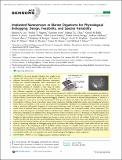Implanted Nanosensors in Marine Organisms for Physiological Biologging: Design, Feasibility, and Species Variability
Author(s)
Lee, Michael A; Nguyen, Freddy T; Scott, Kathleen; Chan, Nathan YL; Bakh, Naveed Ali; Jones, Kelvin K; Pham, Crystal; Garcia-Salinas, Pablo; Garcia-Parraga, Daniel; Fahlman, Andreas; Marco, Vicente; Koman, Volodymyr B; Oliver, Ronald J; Hopkins, Lloyd W; Rubio, Consuelo; Wilson, Rory P; Meekan, Mark G; Duarte, Carlos M; Strano, Michael S; ... Show more Show less
DownloadAccepted version (6.569Mb)
Terms of use
Metadata
Show full item recordAbstract
© 2018 American Chemical Society. In recent decades, biologists have sought to tag animals with various sensors to study aspects of their behavior otherwise inaccessible from controlled laboratory experiments. Despite this, chemical information, both environmental and physiological, remains challenging to collect despite its tremendous potential to elucidate a wide range of animal behaviors. In this work, we explore the design, feasibility, and data collection constraints of implantable, near-infrared fluorescent nanosensors based on DNA-wrapped single-wall carbon nanotubes (SWNT) embedded within a biocompatible poly(ethylene glycol) diacrylate (PEGDA) hydrogel. These sensors are enabled by Corona Phase Molecular Recognition (CoPhMoRe) to provide selective chemical detection for marine organism biologging. Riboflavin, a key nutrient in oxidative phosphorylation, is utilized as a model analyte in in vitro and ex vivo tissue measurements. Nine species of bony fish, sharks, eels, and turtles were utilized on site at Oceanogràfic in Valencia, Spain to investigate sensor design parameters, including implantation depth, sensor imaging and detection limits, fluence, and stability, as well as acute and long-term biocompatibility. Hydrogels were implanted subcutaneously and imaged using a customized, field-portable Raspberry Pi camera system. Hydrogels could be detected up to depths of 7 mm in the skin and muscle tissue of deceased teleost fish (Sparus aurata and Stenotomus chrysops) and a deceased catshark (Galeus melastomus). The effects of tissue heterogeneity on hydrogel delivery and fluorescence visibility were explored, with darker tissues masking hydrogel fluorescence. Hydrogels were implanted into a living eastern river cooter (Pseudemys concinna), a European eel (Anguilla anguilla), and a second species of catshark (Scyliorhinus stellaris). The animals displayed no observable changes in movement and feeding patterns. Imaging by high-resolution ultrasound indicated no changes in tissue structure in the eel and catshark. In the turtle, some tissue reaction was detected upon dissection and histopathology. Analysis of movement patterns in sarasa comet goldfish (Carassius auratus) indicated that the hydrogel implants did not affect swimming patterns. Taken together, these results indicate that this implantable form factor is a promising technique for biologging using aquatic vertebrates with further development. Future work will tune the sensor detection range to the physiological range of riboflavin, develop strategies to normalize sensor signal to account for the optical heterogeneity of animal tissues, and design a flexible, wearable device incorporating optoelectronic components that will enable sensor measurements in moving animals. This work advances the application of nanosensors to organisms beyond the commonly used rodent and zebrafish models and is an important step toward the physiological biologging of aquatic organisms.
Date issued
2019Department
Massachusetts Institute of Technology. Department of Chemical Engineering; Massachusetts Institute of Technology. Division of Comparative MedicineJournal
ACS Sensors
Publisher
American Chemical Society (ACS)